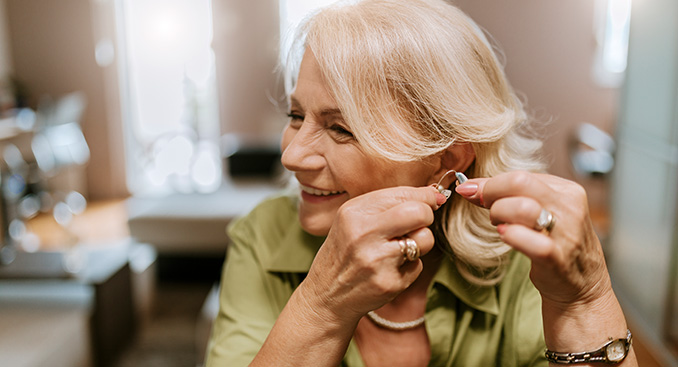Protect Your Investment in Hearing Devices: 5 Essential Tips
Ear, Nose and Throat (ENT), Service Line

June 19, 2019
If you’ve shopped for hearing devices recently or already own a pair, you know that these devices can be expensive so it’s important to take care of them. “They can be well worth the cost for the enhanced quality of life that comes with an improved ability to hear,” says Taylor Remick, AuD., CCC-A, FAAA, PASC, an audiologist with TriHealth, “so it pays to protect your investment.” Dr. Remick recommends the following tips:
1. Be Aware of the Temperature
- Avoid excessive heat and cold. Do not leave your hearing devices in a hot car in the summer or a cold car in the winter.
- Do not dry your hair with a hair dryer while wearing hearing devices.
- Humidity and hearing devices do not mix. If you live in a humid environment, purchase a hearing devices dehumidifier.
2. Avoid Moisture and Water
While a humid environment can damage hearing devices, moisture from perspiration as well as submersion in water can interfere with the functionality of hearing devices.
- Do not wear hearing devices while swimming, showering, taking a bath, or while in the sauna (unless you have an extended-wear, deep canal device).
- Remove your hearing devices at the hairdresser or barber.
- Use an umbrella or hooded raincoat when it is raining.
- Make sure your hair and ears are completely dry before inserting your hearing devices.
- Remove your hearing devices at night and, if possible, open the casing door to allow air to ventilate the interior.
3. Avoid Shock and Vibrations
- Hold the hearing devices over a cushioned surface when changing the battery.
- Store your hearing device in the case it came in.
- To avoid accidents, sit down to insert or remove your hearing devices.
4. Regularly Clean the Outer Shell of your Hearing Devices
- To clean an in-the-ear hearing device externally, wipe it off with a dry cloth. Then brush across the receiver opening with the wax brush that came with your hearing device. If you did not receive a wax brush, consult your audiologist. Do not push anything into the microphone port. To clean wax guards, follow the instructions given to you by your audiologist.
- To clean behind-the-ear hearing devices externally, wipe off the hearing device with a dry cloth. To clean the ear mold, remove it from the ear hook of the hearing devices and wash it in warm, soapy water. Rinse thoroughly and shake out the excess moisture. Allow the ear mold to dry overnight.
- At least every six months, take your hearing devices to your audiologist for a thorough “clean and check” and to change out microphone protectors and BTE tubing that is becoming brittle.
5. Use Hair, Shaving and Cosmetic Products Carefully
- Perfume, hair spray, bath powder, shaving cream, cosmetics and hair gel can all clog the microphone of your hearing devices so always remove devices prior to applying any of the listed products.